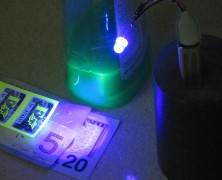Until relatively recently there was no such thing as a commercially available ultraviolet (UV) LED light. But as LED technology continues to develop and power densities increase, UV LED lights are expanding into the market and replacing more traditional alternatives. Ultraviolet (UV) light is an invisible form of electromagnetic energy (light energy) that travels at a higher frequency and carries more energy than visible light. UV lightwaves were originally called “chemical rays” when first discovered in the 19th century because of their ability to cause certain substances to change at the molecular level. Here are a few examples of the many applications for UV LED lighting: Industrial and Cosmetic Curing UV curing is a process that uses UV light to instantly cure (or “dry”) inks, coating and adhesives through cross-polymerization of photosensitive materials. UV LED technology is emerging as an ozone gas- and mercury-free option for chemical curing with both industrial and cosmetic applications. Nail polish cures have traditionally been done using unregulated UV lamps, but controversy arose earlier this year over a study published in the Journal of the American Academy of Dermatology which reported a potential danger of skin cancer. The study found that LED lamps were much safer for this application, due to the lower frequency of UV light they emit. Analytic Tools Due to UV lighting’s ability to make certain materials visible to the human eye, it has been used for quite some time as an analytic tool. One common use for ultraviolet light sources is checking UV watermarks to validate currency, or identifying bodily fluids in forensic crime scenes. Scientific and Biological A 2012 study published in Applied Entomology and Zoology showed that UV LED lights were an effective method for dealing with the West Indian sweet potato weevil. This disagreeable insect...






